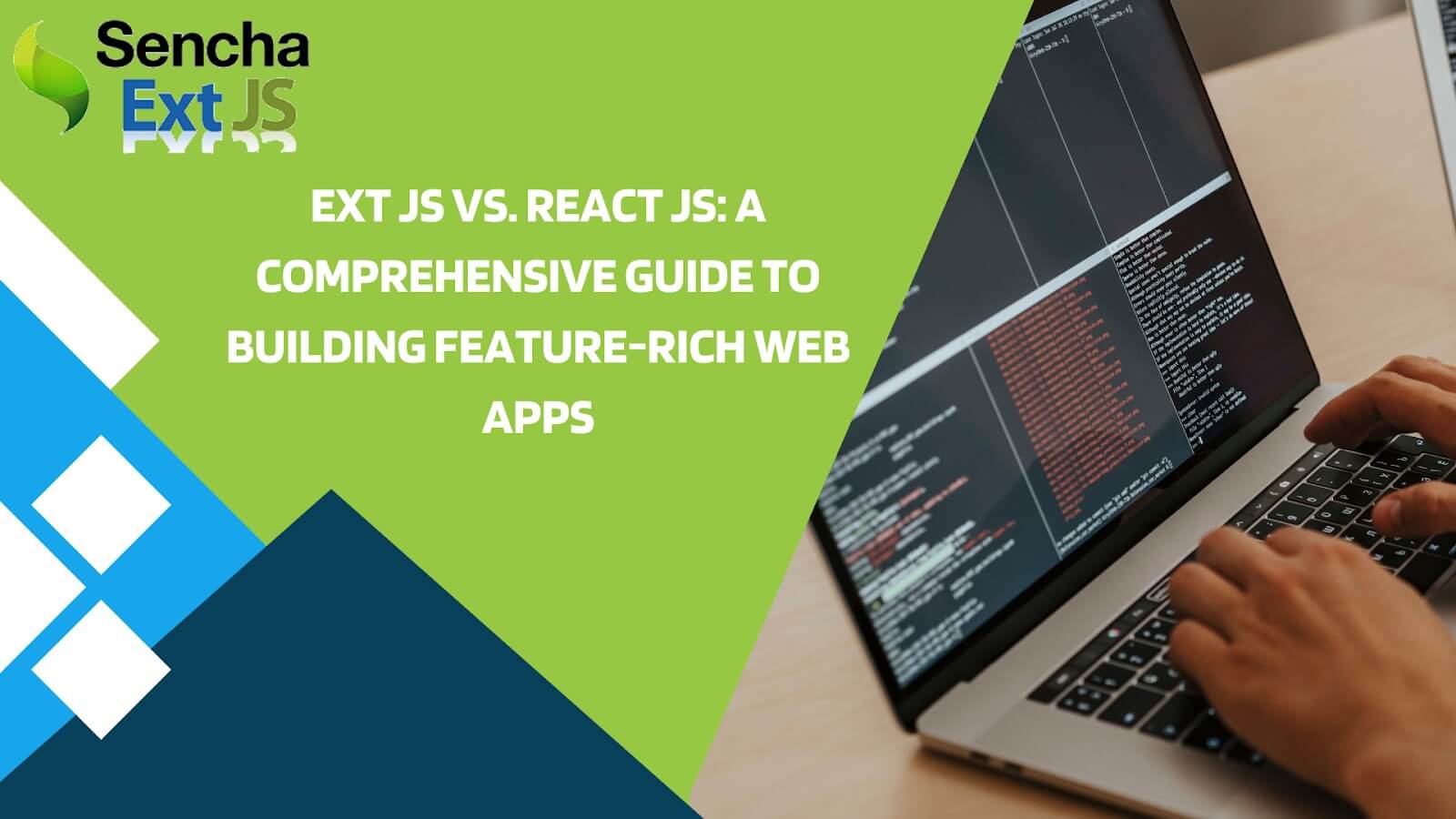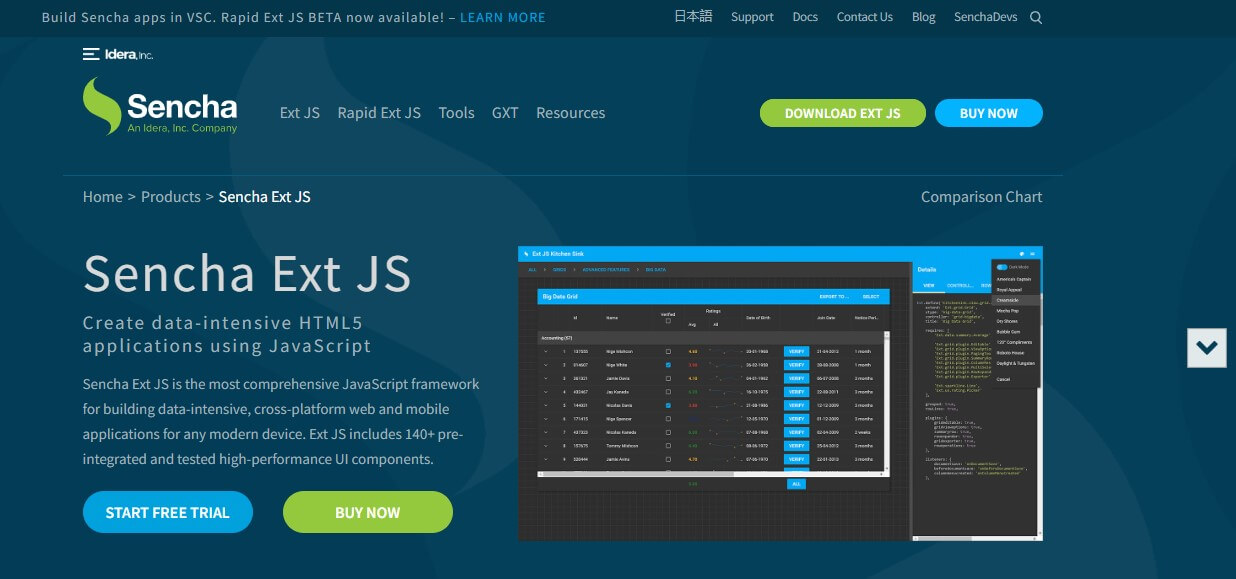Updated October 27, 2023

Ext JS Vs. React JS – Introduction
In web development, choosing the right JavaScript framework is crucial. Ext JS and React JS are two options worth exploring. The main difference between Ext JS vs React JS is that Ext JS is best suited for creating entire applications for desktop and mobile. On the other hand, React JS is best for creating user interfaces for any application.
This guide will explain these frameworks and how they help create web apps. We will also discuss factors to consider when choosing between them, like your project’s needs, scalability, and developer skills. This guide aims to help you make an informed decision about which framework to use in web development.
What Is Ext JS?
Ext JS is a JavaScript framework that helps users build web applications. It was created by Jack Slocum in 2007, who later founded Sencha Inc. in 2010, originally called YUI-Ext, before becoming Ext JS.
Key Features
- Component-based: Ext JS is known for its component-based structure, which simplifies the process of building web apps. It makes it easy for developers to create reusable user interface (UI) elements.
- Rich UI Widgets: It offers a variety of pre-built UI widgets like grids, charts, and forms. These widgets help create a polished and user-friendly experience for your web application users.
- Data Package: Ext JS includes a robust data package that makes it easier to work with data. It allows data binding, manipulation, and integration with different data sources.
Use Cases of Ext JS
Ext JS is great for building large, business-level applications such as CRM systems, data dashboards, and complex administrative tools. It has many features and data-handling abilities, making it perfect for applications that require a sophisticated user interface.
What Is React JS?
React JS, or React, is a popular JavaScript library that helps developers create user interfaces. Developed by Facebook and released in 2013, it is popular due to its efficiency and flexibility in creating dynamic web applications.
Key Features
- Architecture: We can easily break down several UI components into reusable building blocks using React. This promotes code reusability and easy maintenance.
- Virtual Document Object Model: React uses a virtual webpage representation to make rendering more efficient. It speeds up the performance by reducing unnecessary changes.
Use Cases of React JS
React JS helps create single-page applications (SPAs) where real-time updates and smooth user experiences matter. They are also perfect for ecommerce platforms, social media sites, and content-driven applications.
What Is the Difference Between Ext JS Vs React JS?
Here are the top 8 differences between Ext JS vs. React JS.
| Aspect | Ext JS | React JS |
| Architecture | It has a comprehensive component-based system with pre-built UI components. | It also has a component-based system but also lets us choose additional UI libraries. |
| Component Library Includes | Grids, charts, forms, and more. | Tables, buttons, maps, and more. |
| Data Handling | Known for robust and efficient data handling, especially for large datasets. | Allows the use of additional libraries (Redux or MobX) for handling extensive data. |
| Rendering | It provides features like buffered rendering for improved performance. | Utilizes a virtual DOM that allows faster rendering. |
| Complexity | Can be challenging due to an extensive API, requiring more time to learn. | Its structure is easy to understand, allowing for a smoother developer experience. |
| Community and Ecosystem Support | Has a smaller but dedicated community, providing commercial support through Sencha. | Has a large and active open-source community. |
| Pros |
|
|
| Cons |
|
|
Ext JS Vs React JS – How to Choose the Right JavaScript Framework?
Some factors given below can influence your choice between these two JavaScript frameworks.
Choose Ext JS If:
- Project Requirements: If you are working with complex data, require extensive pre-built UI components and a consistent, integrated framework.
- Development Team: If your team has experience with Ext JS or a background in working with comprehensive frameworks.
- Scalability: Use Ext JS if you want higher scalability, as its architecture makes it suitable for building large-scale applications.
- Community & Support: If you are aware of the size and activity of the developer community and the power of Sencha with Ext.js.
Choose React JS If:
- Project Requirements: If you want flexibility in selecting what components to use and a more lightweight, adaptable approach to UI development.
- Development Team: If you have a team of fast learners (React JS is easier to learn) or with varying levels of expertise in web development.
- Scalability: Choose React JS if you are working on a small-scale project. It is because React JS may require additional libraries to manage more massive projects.
- Community & Support: If your team may need an extensive community and abundant open-source resources.
Final Thoughts
In web development, choosing the proper framework is vital. In this guide, we have explored Ext JS and React JS, two robust JavaScript frameworks, to help you decide. The choice depends on your project, team skills, and long-term goals.
Frequently Asked Questions (FAQs)
Q1. Is Ext JS free to use for commercial projects?
Answer: Yes, to use Ext JS for commercial projects, you can get a free Ext JS license. However, it provides limited features. To use other extensive features, you need to get a commercial license.
Q2. How can I get started with Ext JS development?
Answer: To start with Ext JS development:
- Install Ext JS
- Explore documentation
- Experiment with basic components and layouts.
Q3. Is JQuery a JS framework?
Answer: jQuery is not a JavaScript framework but a JavaScript library designed to simplify DOM manipulation and event handling.
Recommended Articles
This is EDUCBA’s guide on the major differences between Ext JS vs React JS. If you found this helpful, you can check the following articles,



